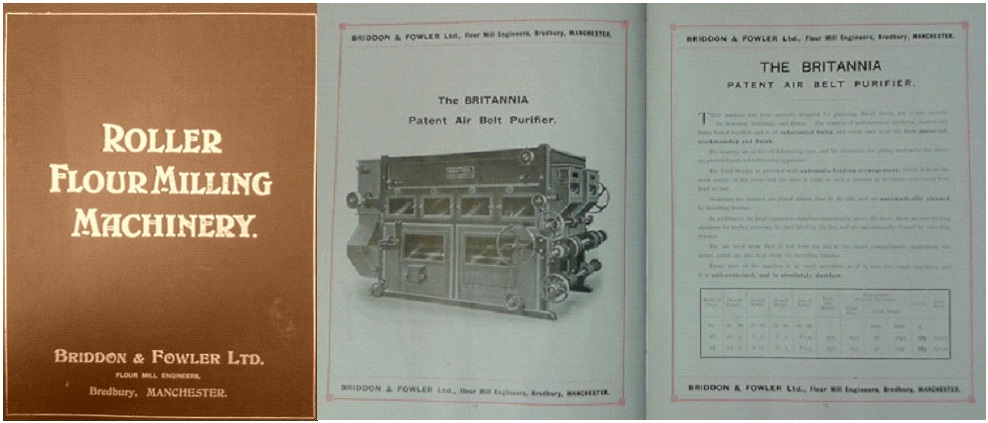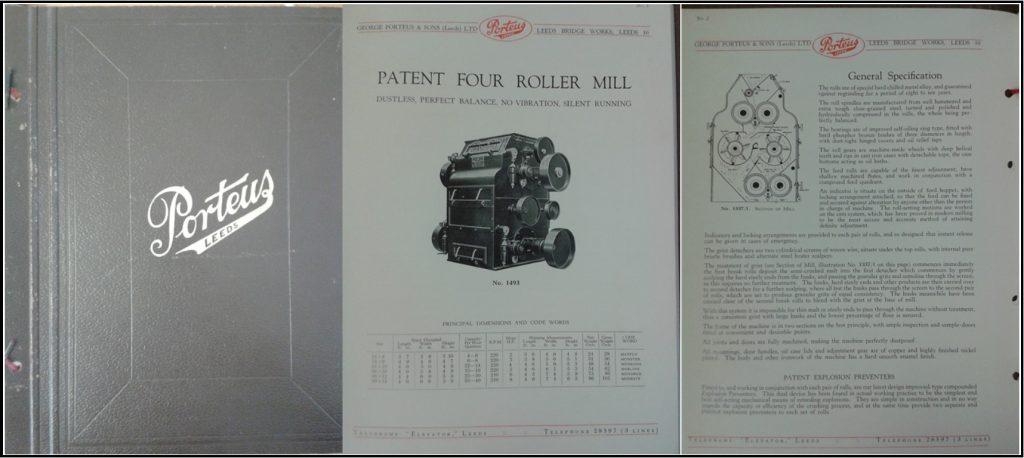A type of publication that provides valuable information about the roller milling trade, are the catalogues produced by engineers and manufacturers. Catalogues advertised the different machines that firms produced, with accompanying details such as illustrations, dimensions and price. Whilst today this sort of information could be found online, during the 19th, and most of the 20th century, these catalogues were the main way a prospective buyer could learn about the latest machinery. As such, catalogues are an invaluable historical source, providing details about how the roller milling trade developed over the years. The Mills Archive is proud to house many examples of these publications, which have aided in the completion of this and other articles.

The main purpose of a catalogue is to advertise and provide details about the goods produced by the firm publishing the catalogue. As such, it was imperative that all the information required was supplied and that it was well presented. Therefore, it is somewhat unsurprising that the different engineering firms adopted similar layouts and structures for their publications. The 1898 Henry Simon Ltd. Modern Flour Mill Machinery catalogue; the 1908 Thomas Robinson and Son, Ltd. catalogue; and the 1914 Briddon & Fowler Ltd. Roller Flour Milling Machinery catalogue, all divided the machinery in their catalogues into three sections: wheat cleaning machinery; roller milling machinery; and accessories. The pages also had a similar format, with an illustration on one page and further descriptions and details on the following page, see image on the right for comparison of the layout for three-high roller mills by Briddon and Fowler and Henry Simon Ltd. These similarities across firms would have made the catalogues easy to use.

Another useful comparison that can be made between catalogues is to compare editions published by the same firm over a period of time. This makes it possible to track the progression and advancement of machinery. For example, the image on the left displays the two-roller mill produced by Henry Simon Ltd., as displayed in their 1898 and 1930 catalogues. The machine has gone through different developments, with the 1930 example looking much more modern than the 1898 example. Additional catalogues produced between these two dates would allow for the tracking of the progressions even more.
Furthermore, the developments of machinery in these catalogues help track the progression of the manufacturing firms themselves. For example, the page following the ‘Simon’ two-roller mill, used in the previous example from 1930, describes the ‘Alphega System’. This system was also described in the 1914 catalogue published by Briddon and Fowler, and was in fact invented by them. The inclusion of this system in a Henry Simon Ltd. catalogue reflects the changing nature of manufacturing firms as they were amalgamated or acquired over time (Briddon and Fowler amalgamated with Henry Simon Ltd. in 1915).
Along with clues from the machinery as to the development of a manufacturing firm, some catalogues include further specific information about the firms. This could be accomplished by the inclusion of an illustration or description of the manufacturing works. In a catalogue produced by Thomas Robinson & Son Ltd., in 1908, there was a ‘new view of the works which has been specially drawn for this catalogue, and shows the latest extensions made to shops’ (‘Reviews’, p.184). Furthermore, Henry Simon Ltd.’s Flour Mill Machinery catalogue from 1930 contained photographs of the Cheadle Heath works and the different production floors. The inclusion of these illustrations and images would allow the client to see the premises where their machinery would be built, without having to leave their mill.

Moreover, some firms included even more additional information in their catalogues, turning the publication into something more than just a book of machinery. The most notable firm to do this was Henry Simon Ltd. In ‘1886, 1893 and 1898 Simon published catalogues in which he included appraisals of technical progress and statements of numbers of plants installed on the Simon system’ (Jones, p.98). These ‘appraisals of technical progress’ were included in the introductory essays Henry Simon wrote for these catalogues, which also included a history of the roller milling trade and his firm’s involvement in it. Furthermore, these catalogues also contained a description of mills where Simon machinery had been installed, along with illustrations of such mills and plants. In the 1886 On Roller Flour Milling catalogue, Simon included plates and descriptions of five mills he had installed machinery into, whereas in the 1898 Modern Flour Mill Machinery catalogue, this number had increased to twenty-seven. The inclusion of this additional information turns these publications into truly valuable sources from the period, providing a contemporary voice for the developments that took place.

After a catalogue had been published, the firm had to deal with the problem of advertising and distributing the publication. The solution most firms used was to send a copy of the catalogue to a milling journal, such as The Miller. These journals would then note the publication of the new catalogue and review them. Indeed, in 1908, The Miller received and reviewed approximately 13 catalogues and lists, including two by the firm E. R. & F. Turner, one ‘Grain Milling Catalogue’ and one catalogue of their ‘steam engines and boilers’ (‘Catalogue’, p.375; TM, January 1908, p.757). The Grain Milling Catalogue was described as being ‘well illustrated with the firm’s well-known machines suitable for all classes of trade in almost all parts of the world’ (‘Catalogue’, p.375). It also included the useful information that ‘our readers can be supplied with copies by simply asking for them’ (‘Catalogue’, p.375). They could ask for them either at the Turner offices in Mark Lane, or at their manufacturing works, St. Peter’s Ironworks, Ipswich. Conversely, one could just send a ‘post card’ to either of the two premises which would ‘bring a copy by return of post’ (TM, January 1908, p.757). Reviews such as this provided the impetus and information a reader would need to acquire their own copy.
Catalogues are therefore very interesting and informative publications, each providing a unique reflection of the roller milling trade. As already mentioned, the archive houses and has access to a variety of catalogues produced by different firms, including Henry Simon Ltd., Briddon and Fowler, and E. R. & F. Turner. Here is a glimpse of some of the catalogues and the information they contain:






Sources:
‘Catalogue’, The Miller, August 3, 1908, p.375.
‘Reviews’, The Miller, May 4, 1908, p.184.
The Miller, January 6, 1908, p.757.